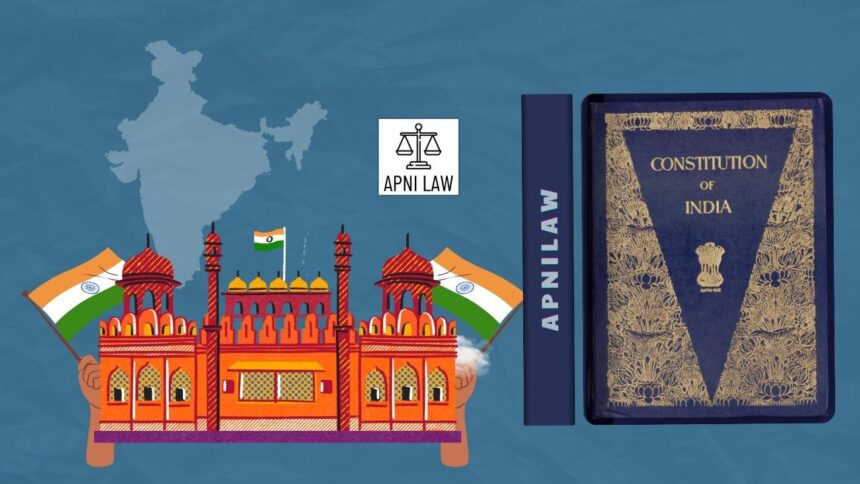Introduction
Articles 245 to 255 of the Indian Constitution deal with legislative relations between the Union and the States. These provisions define the authority of Parliament and State legislatures, the scope of their law-making powers, and the mechanisms to resolve conflicts. They also lay down rules for exceptional situations where Parliament may legislate on matters reserved for the States. Together, these articles form the backbone of India’s federal legislative structure.
India’s Constitution establishes a federal framework, but it tilts in favor of the Centre. The distribution of legislative power reflects the idea that while States enjoy autonomy, Parliament retains the ultimate authority under certain circumstances. This arrangement ensures national unity while allowing regional diversity.
How Is Legislative Power Divided by Territory and Subject?
Article 245 defines the territorial limits of legislative authority. Parliament can make laws for the entire country or any part of it. State legislatures can frame laws for their respective territories. Parliament’s laws can even extend beyond Indian territory, giving it extra-territorial scope. States, however, cannot legislate beyond their boundaries unless there is a territorial nexus with the subject.
Article 246 provides the subject-matter division of legislative powers. The Seventh Schedule contains three lists, Union, State, and Concurrent. The Union List covers matters like defense, foreign affairs, and atomic energy, which are exclusively under Parliament’s control. The State List includes subjects like police, agriculture, and public health, reserved for States. The Concurrent List contains matters like criminal law, marriage, and education, where both Parliament and State legislatures can legislate.
When a conflict arises in the Concurrent List, Article 246 makes it clear that Parliamentary law prevails. State law becomes void to the extent of the inconsistency unless it has received the President’s assent. Even then, Parliament can override such State laws later. This arrangement shows the supremacy of Union law in case of conflict.
When Can Parliament Make Laws on State Matters?
Normally, matters in the State List are reserved for State legislatures. However, the Constitution allows Parliament to intervene in special situations. Article 249 enables Parliament to legislate on State List subjects if the Rajya Sabha declares it necessary in the national interest. Such a resolution requires a two-thirds majority and remains valid for one year, though it can be extended.
Article 250 empowers Parliament during a national emergency. In such times, Parliament can legislate on State List subjects, and these laws remain valid until six months after the emergency ends. This ensures a strong central authority in times of crisis.
Article 252 provides another route. If two or more State legislatures consent, Parliament can make laws on matters in the State List. Other States can later adopt the same law by passing resolutions. For instance, Parliament has enacted laws on civil procedure and urban planning based on resolutions passed by States.
Through these provisions, Parliament gains conditional powers over subjects normally reserved for States. This shows how flexibility is built into India’s federal system.
How Do Treaties and International Obligations Affect State Powers?
Article 253 empowers Parliament to make laws for implementing international treaties, agreements, and conventions. This power extends even to matters in the State List. The purpose is to ensure that India meets its international commitments without facing internal obstacles.
For example, when India signed the Kyoto Protocol, Parliament enacted laws on environmental protection even though such matters are also connected with the State List. Thus, Article 253 provides a constitutional basis for Parliament to override States in matters of international concern.
How Are Conflicts Between Union and State Laws Resolved?
Conflicts between Union and State laws are addressed under Article 254. When a State law is inconsistent with a Union law in the Concurrent List, the Union law prevails. The State law becomes void to the extent of the repugnancy.
However, if a State law has received the President’s assent, it can prevail within that State, even if inconsistent with Union law. Yet, Parliament retains the authority to later override such State law by enacting fresh legislation. This principle of repugnancy ensures harmony in law-making while keeping Union supremacy intact.
The courts play an important role in interpreting these conflicts. Judicial rulings have repeatedly upheld the dominance of Union laws when disputes arise. For example, in M. Karunanidhi v. Union of India (1979), the Supreme Court clarified the scope of repugnancy under Article 254.
What Additional Provisions Regulate Legislative Relations?
Apart from territorial and subject-matter divisions, Articles 245 to 255 cover other issues. They address matters like the requirement of Presidential assent for certain laws, the role of Union territories, and administrative directions to States regarding legislation.
For instance, Article 255 clarifies that laws requiring prior recommendation or assent do not become invalid merely because these procedures were not followed, as long as assent is ultimately given. These safeguards prevent technical lapses from nullifying legislative actions.
Why Does the Constitution Give the Centre More Power?
The legislative scheme in Articles 245–255 reflects a strong tilt toward the Centre. This was a deliberate choice by the Constitution makers. India’s diversity, history of partition, and challenges of integration required a strong central authority. Unlike the United States, where states enjoy greater sovereignty, India adopted a model where Parliament holds the final say in legislative conflicts.
This does not mean States lack autonomy. They can legislate freely on matters in the State List as long as they stay within constitutional limits. Yet, in emergencies or matters of national interest, Parliament’s authority prevails. This balance of autonomy and central supremacy creates what scholars call “quasi-federalism.”
How Do These Articles Impact Centre-State Relations Today?
In practice, legislative relations under Articles 245–255 continue to shape Indian federalism. Disputes often arise over taxation, natural resources, and fiscal transfers. For example, the introduction of the Goods and Services Tax reduced States’ taxation powers and increased their reliance on the Centre. This has led to demands for greater financial autonomy.
Judicial interpretations also influence these relations. The Supreme Court has repeatedly emphasized cooperative federalism, urging both Centre and States to work together. Yet, tensions surface when States accuse the Centre of encroaching on their legislative domain. The debates over farm laws and environmental regulations illustrate such conflicts.
What Is the Role of the Seventh Schedule in Legislative Relations?
The Seventh Schedule is central to understanding Articles 245–255. It distributes subjects between Union, State, and Concurrent Lists. The Union List today contains 100 subjects, the State List 61, and the Concurrent List 52. This distribution reflects the dominance of Parliament, as Union subjects include critical areas like defense, banking, and atomic energy.
Over time, the Union List has expanded while the State List has shrunk. This shift reflects India’s move toward greater centralization. Yet, States continue to play a vital role in sectors like agriculture, healthcare, and policing, where local conditions matter most.
How Does This Framework Balance Unity and Diversity?
India’s legislative framework seeks to balance unity with diversity. By granting Parliament supremacy, the Constitution ensures national integrity. At the same time, by reserving certain subjects for States, it preserves local autonomy. The Concurrent List reflects the need for cooperation in shared matters.
This balance has not always been smooth. Conflicts, disputes, and accusations of overreach persist. However, the framework of Articles 245–255 ensures that there are constitutional solutions to these issues. The judiciary, the President’s role in assent, and mechanisms like Rajya Sabha resolutions provide checks and balances.
For any specific query call at +91 – 8569843472
Conclusion
Articles 245 to 255 reveal the unique character of Indian federalism. They establish a federal division of legislative powers but lean in favor of the Centre. Parliament enjoys supremacy in times of conflict, emergencies, or international obligations, while States retain autonomy in defined spheres.
This framework highlights India’s pragmatic approach. Instead of rigid federalism, India adopted a flexible model where central authority can expand during crises but retract in normal times. This design has ensured stability, unity, and adaptability in a diverse nation.
The legislative relations under Articles 245–255 thus reflect the vision of the Constitution makers, a Union that is strong enough to maintain integrity, yet flexible enough to respect diversity.








